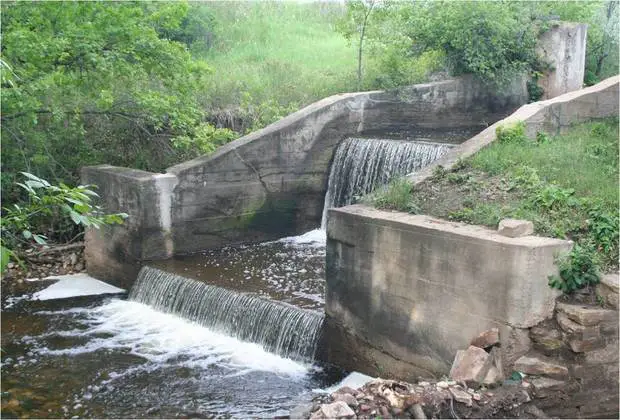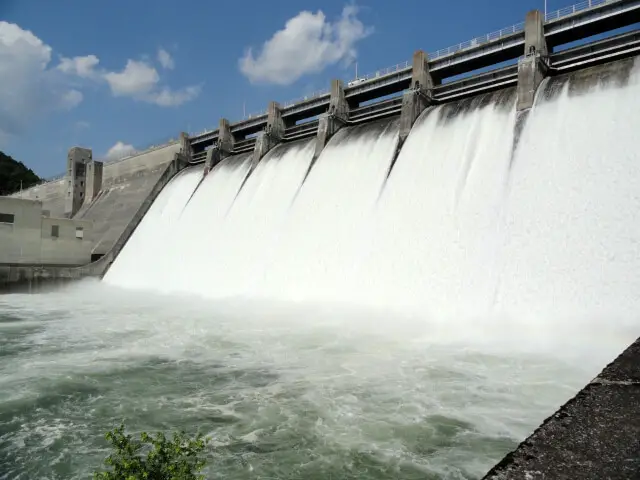What are spillways?
A spillways is a structure constructed at a dam site, for effectively disposing of the surplus water from upstream to downstream. Just after the reservoir gets filled up, up to normal pool level.
Types of spillways
Depending upon the type of the structure constructed for disposing of the surplus water the spillways can be of the following major types
- Straight Drop Spillway
- Ogee Spillway
- Open Channel Spillway
- Side channel Spillway
- Shaft Spillway
- Siphon Spillway
- Chute Spillway
1. Straight Drop Spillway

In this type of spillway, Over flowing water falls freely in vertical direction on the downstream side of the hydraulic structure. Straight drop spillway are mainly suitable for weirs and low dams.
A nose is provided at the crest of the spillway so that the water jet may not strike the downstream base of the spillway structure. In order to protect the spillway structure from the effect of scouring horizontal impervious apron should be provided on the downstream side. Sometimes a basin is constructed on the downstream side to form a small artificial pool which is known as water cushion as shown in the below image. This water cushion serves the purpose of energy dissipater.

2. Ogee Spillway

These type of spillways are improved form of drop spillway, ogee spillway are usually provided in a rigid dams like arc dam, gravity dam and buttress dams. The downstream face of the weir is constructed corresponding to the shape of lower nappe of freely falling water jet which is in ogee shape.
These spillway are generally designed on the basis of principal of projectile. where, the shape of lower nappe of water jet is not constant for all water heads. Hence the shape obtained form the maximum head is taken into consideration while designing ogee spillway.
3. Open Channel Spillway
These spillways are generally provided in a certain conditions like, Where it is not possible to provide a drop spillway or overflow spillway and some other conditions like narrow valley or where there is no availability of separate site for the spillways.
Usually this type of spillways are provided in Non rigid dams like rockfill dams, earth dams and away from the main dam.
4. Side channel Spillway
Side channel spillways are located just upstream and to the side of the dam. The water after flowing over a crest enters a side channel which is nearly parallel to the crest. This is then carried by a chute to the downstream side. Sometimes a tunnel may be used instead of a chute.
This type of spillway is good choice where there is a long overflow crest is desired in order to limit the surcharge head and the abutment are steep.
5. Shaft Spillway

Shaft spillway utilizes a crest circular in plan, Where the flow over which is carried by a vertical or sloping tunnel on to a horizontal tunnel nearly at the stream bed level and eventually to the downstream side. The diversion tunnels constructed during the dam construction can be used as the horizontal conduit in many cases.
The inlet hole of the vertical shaft is specially shaped which is called as morning glory or glory hole of the spillway. Hence, shaft spillway is also called as Morning glory spillway or Bell Mouth spillway. Shaft spillway is recommended when there is no space to provide for other types of spillways such as ogee spillway, straight drop spillway, etc.
6. Siphon Spillway

This type of spillway works on siphon principle as mentioned in the name itself. In siphon spillway, the excess of water is disposed to the downstream through a inverted u shaped conduit or Channel. which is generally arranged inside the body or over the crest of the dam.
Air vents are provided at the bent portion of the upper passageway to prevent the entrance of water when the water level is below the normal poll level. Whenever the level rises above normal pool level, water enters into the conduit and is discharged to the downstream of the channel by siphonic action.
7. Chute Spillway

In this type of spillway, the excess of water from the upper stream is disposed to the downstream through a steeply sloped open conduit or channel. which is called “chute or trough”.
The flow through the channel is super-critical. The spillway can be provided close to the dam or at a suitable saddle away from the dam where site conditions permit.
Chute spillway is generally suitable for earthen dam, rockfill dams where the width of river valley is narrow.
Also read – What are the Causes of Failure of Earthen Dam

